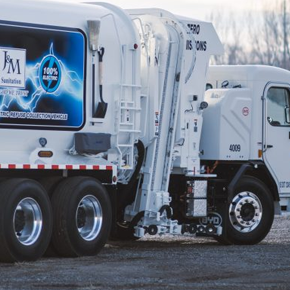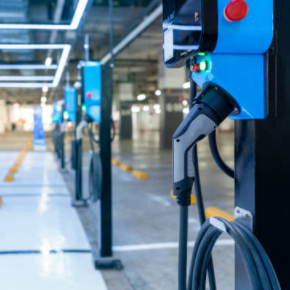Realize the Benefits of Electric Vehicles
The EV market is rapidly expanding, offering new opportunities for your business.

Fleets
Lower operating costs and low-to-no tailpipe emissions are just some of the benefits of electric transportation. Paired with a range of incentives, exploring an EV fleet transition may be a smart move for your organization.

Customers
Attract customers and encourage them to stay longer by installing EV charging stations.

Employees
Recruit and retain employees by offering workplace charging.
This Commercial EV site has the information you need to start the transition. While EVs provide many benefits, we understand implementing a sustainable fleet is ultimately a total cost of ownership decision. Our Commercial EV resources help you understand the impacts of an EV fleet conversion, identifying candidate vehicles, reviewing available incentives and rate programs, calculating your potential savings and evaluating your carbon impact. Case studies show how businesses like yours have made the transition.
The tools can also help you select the charging solution that is right for your fleet, your customers and employees. Use this tool to evaluate the different charging stations on the market or find public charging near you.
Idaho Power is here to help you meet your fleet, budget and climate action goals.
Idaho Power has some of the lowest electricity rates in the nation and an energy mix with abundant clean hydroelectric and other renewable resources.
Idaho Power is here to help, contact us early on in your project to assist with evaluation and implementation of your fleet electrification. Contact us at ev@idahopower.com.

Electric vehicle fleets cost less to operate and maintain.
Mile for mile, EVs cost less to fuel than diesel and gas vehicles. While initial buyer interest in EVs generally focuses on fuel savings from a total cost of ownership perspective, operations and maintenance costs also represent a significant savings opportunity. Electric prices are also generally much more stable than gasoline prices. On a national average, it costs less than half as much to travel the same distance in an EV than a conventional vehicle. Your savings could be more substantial if your current gas powered vehicle gets poor mileage. Plus, with instant acceleration, EVs are fun to drive.

Electric vehicles are much simpler systems to maintain in comparison to internal combustion engines.
There are about 20 moving parts in an EV drivetrain, compared to 2000 in a combustion vehicle. Electric propulsion removes the need for spark plugs, fuel controls, oils or other fluids, and with regenerative braking systems, even wear and tear on braking costs are comparatively lower. With less moving parts to maintain, EV fleets save you money and time on replacement and service costs.
Electric vehicles have fewer environmental impacts.
Pure electric vehicles have zero tailpipe emissions helping to protect our airsheds and meet sustainability goals. For vehicles used indoors or with open cabs like forklifts, switching to electric protects workers from air pollutants associated with diesel, gas or propane. They are quieter too.
EVs do not have the same fuel or oil requirements, reducing hazardous materials management and storage associated with internal combustion engines.
Vehicle manufacturers may have recommended charging solutions, provide driver and maintenance services. Be sure to discuss maintenance, battery life and replacement, and warranties.
Electricians will help navigate all codes and permitting requirements.
Idaho Power can identify necessary site improvements, evaluate billing impacts and suggest ways to manage energy use.
The tools can also help you select the charging solution that is right for your fleet, your customers and employees. Use this tool to evaluate the different charging stations on the market or find public charging near you.
Idaho Power is here to help you meet your fleet, budget and climate action goals.
Idaho Power has some of the lowest electricity rates in the nation and an energy mix with abundant clean hydroelectric and other renewable resources.
Idaho Power is here to help, contact us early on in your project to assist with evaluation and implementation of your fleet electrification. Contact us at ev@idahopower.com.
Getting Started
The following section outlines a general process for reviewing fleet electrification for your business. Every business has it's own unique operational requirements, so you may have additional considerations. This is intended to provide a general framework to help shape your options.Consider the benefits.

Electric vehicle fleets cost less to operate and maintain.
Mile for mile, EVs cost less to fuel than diesel and gas vehicles. While initial buyer interest in EVs generally focuses on fuel savings from a total cost of ownership perspective, operations and maintenance costs also represent a significant savings opportunity. Electric prices are also generally much more stable than gasoline prices. On a national average, it costs less than half as much to travel the same distance in an EV than a conventional vehicle. Your savings could be more substantial if your current gas powered vehicle gets poor mileage. Plus, with instant acceleration, EVs are fun to drive.

Electric vehicles are much simpler systems to maintain in comparison to internal combustion engines.
There are about 20 moving parts in an EV drivetrain, compared to 2000 in a combustion vehicle. Electric propulsion removes the need for spark plugs, fuel controls, oils or other fluids, and with regenerative braking systems, even wear and tear on braking costs are comparatively lower. With less moving parts to maintain, EV fleets save you money and time on replacement and service costs.
Electric vehicles have fewer environmental impacts.
Pure electric vehicles have zero tailpipe emissions helping to protect our airsheds and meet sustainability goals. For vehicles used indoors or with open cabs like forklifts, switching to electric protects workers from air pollutants associated with diesel, gas or propane. They are quieter too.
EVs do not have the same fuel or oil requirements, reducing hazardous materials management and storage associated with internal combustion engines.
Identify opportunities and objectives.
Businesses around the world are beginning to see the value of converting their fleets to electric for a variety of reasons. Some are seeking lower operational costs, some are seeking carbon reduction and others are interested in developing a healthier work environment. We've complied an extensive database of case studies and incentive information to help you see what other companies are doing across the country.
Find vehicles that meet your fleet requirements.
There are electric options for most light, medium and heavy vehicles. Some vehicle classes are readily available and have many successful implementations around the country, while other classes are in earlier stages of development/adoption and are currently being vetted through pilot programs. Review or directory of electric vehicles to see if there is a model that fits your needs. And remember, if a vehicle that meets your needs isn’t available today, it will likely be in the near future. Check out our incentives page to see what grants, incentives or rebates may be available.
Estimate your fuel savings.
Electric vehicles generally represent a tremendous opportunity to reduce fleet fuel and maintenance costs, while substantially reducing environmental impacts. These reductions can be measured in a variety of ways - visit our Fleet Savings Estimator to learn more.
Develop a preliminary charging infrastructure plan.
Charging infrastructure is a major consideration when reviewing cost and convenience. Charging requires careful planning and ongoing attention to ensure you're maximizing the benefits of electrification.
Engage with partners.
Good partners can help with planning, budgeting, permitting and installation. Make sure to engage early with trusted partners that can help get the job done efficiently. Gain Internal Commitment
Although EVs do have many things in common with their internal combustion engine relatives, fleet conversion does require consideration for skill transition and equipment acquisition for in-house maintenance teams. We recommend building a strong relationship with the manufacturer, including considering negotiating specific training opportunities and performance warranties.
Continuous Improvement
Once up and running, maintain a relationship with project partners. Reach out to Idaho Power often to ensure you continue to optimize your charging solutions and leverage the best rates to power your fleet.







